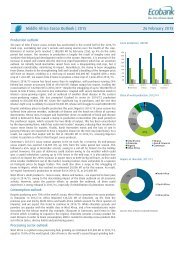www.ebook777.com
Make_Getting_Started_with_Processing_Second_Edition
Make_Getting_Started_with_Processing_Second_Edition
Create successful ePaper yourself
Turn your PDF publications into a flip-book with our unique Google optimized e-Paper software.
152 Getting Started with Processing<br />
<strong>www</strong>.<strong>ebook777.com</strong><br />
We’ll spend the rest of this chapter talking about the details that<br />
make this example possible.<br />
Make an Array<br />
Each item in an array is called an element, and each has an<br />
index value to mark its position within the array. Just like coordinates<br />
on the screen, index values for an array start counting<br />
from 0. For instance, the first element in the array has the index<br />
value 0, the second element in the array has the index value 1,<br />
and so on. If there are 20 values in the array, the index value of<br />
the last element is 19. Figure 11-1 shows the conceptual structure<br />
of an array.<br />
Figure 11-1. An array is a list of one or more variables that share<br />
the same name<br />
Using arrays is similar to working with single variables; it follows<br />
the same patterns. As you know, you can make a single integer<br />
variable called x with this code:<br />
int x;<br />
To make an array, just place brackets after the data type:<br />
int[] x;<br />
The beauty of creating an array is the ability to make 2, 10, or<br />
100,000 variable values with only one line of code. For instance,<br />
the following line creates an array of 2,000 integer variables:<br />
int[] x = new int[2000];<br />
You can make arrays from all Processing data types: boolean,<br />
float, String, PShape, and so on, as well as any user-defined<br />
class. For example, the following code creates an array of 32<br />
PImage variables:



